Toyota's Global Environment: Management and Organizational Culture
VerifiedAdded on 2023/06/12
|9
|1589
|104
Report
AI Summary
This report provides an analysis of Toyota's corporate culture within a global environment, focusing on the seven dimensions of organizational culture and the cultural web model. It examines Toyota's emphasis on teamwork, continuous improvement, quality, secrecy, fair management, a healthy working environment, and effective communication. The report also evaluates the effectiveness of the cultural web model in changing corporate culture, comparing it to typology-based approaches like hierarchy, market, adhocracy, and clan models. It concludes that Toyota's culture, while facing challenges in diversification, remains a key factor in its competitiveness and success, emphasizing the importance of accommodating diverse perspectives within the organization. This document is available on Desklib, a platform offering a wide array of study tools and solved assignments for students.
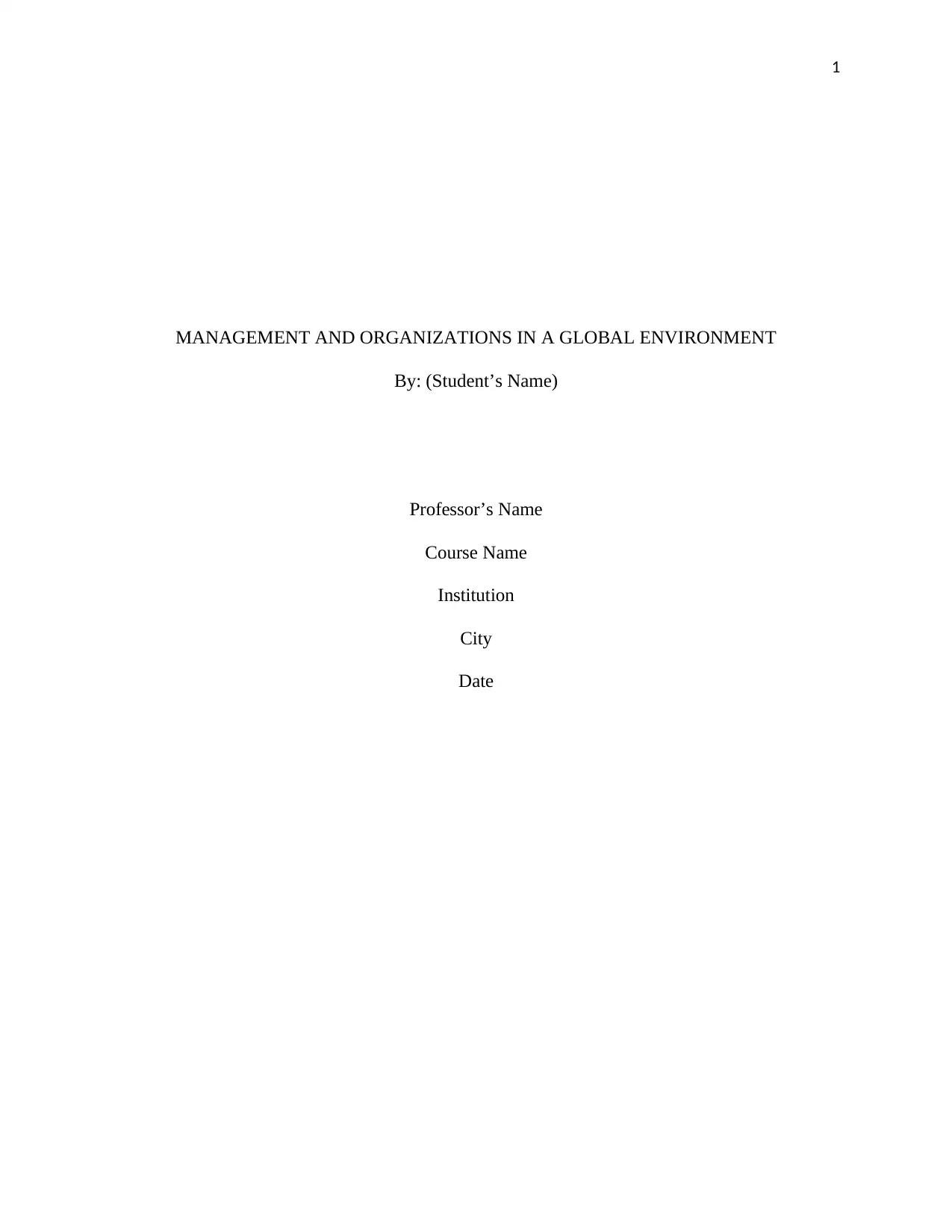
1
MANAGEMENT AND ORGANIZATIONS IN A GLOBAL ENVIRONMENT
By: (Student’s Name)
Professor’s Name
Course Name
Institution
City
Date
MANAGEMENT AND ORGANIZATIONS IN A GLOBAL ENVIRONMENT
By: (Student’s Name)
Professor’s Name
Course Name
Institution
City
Date
Paraphrase This Document
Need a fresh take? Get an instant paraphrase of this document with our AI Paraphraser
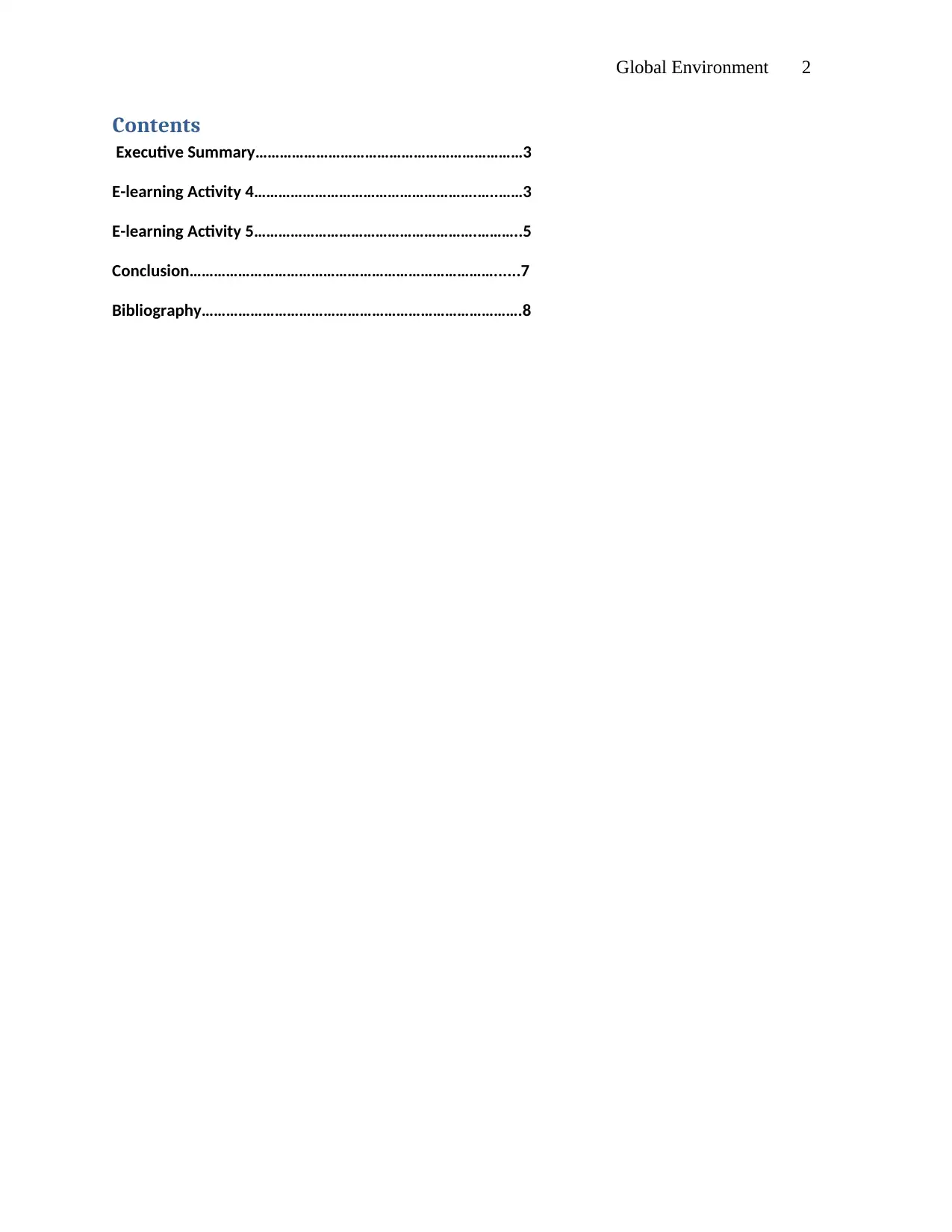
Global Environment 2
Contents
Executive Summary…………………………………………………………3
E-learning Activity 4……………………………………………….…..……3
E-learning Activity 5……………………………………………….………..5
Conclusion…………………………………………………………………......7
Bibliography…………………………………………………………………….8
Contents
Executive Summary…………………………………………………………3
E-learning Activity 4……………………………………………….…..……3
E-learning Activity 5……………………………………………….………..5
Conclusion…………………………………………………………………......7
Bibliography…………………………………………………………………….8
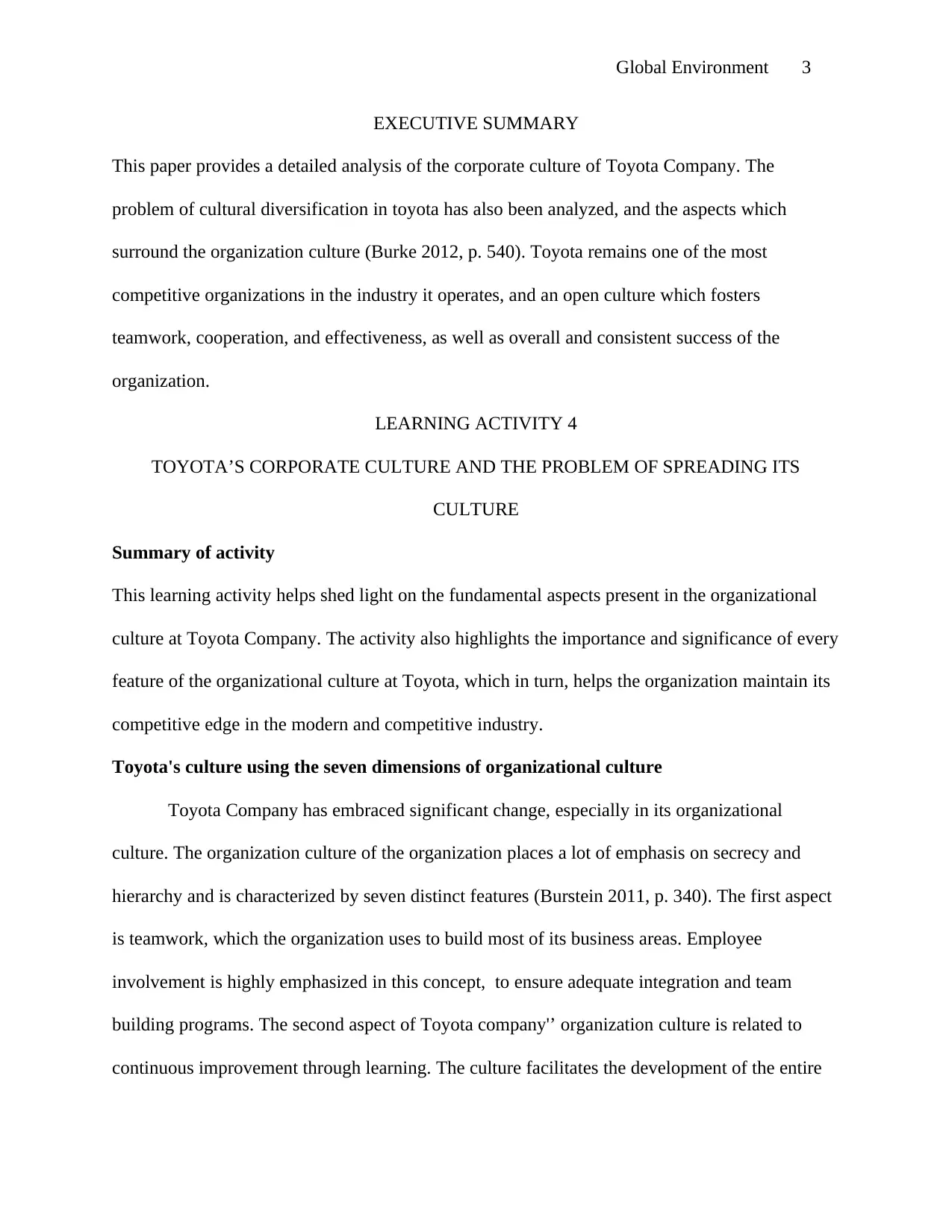
Global Environment 3
EXECUTIVE SUMMARY
This paper provides a detailed analysis of the corporate culture of Toyota Company. The
problem of cultural diversification in toyota has also been analyzed, and the aspects which
surround the organization culture (Burke 2012, p. 540). Toyota remains one of the most
competitive organizations in the industry it operates, and an open culture which fosters
teamwork, cooperation, and effectiveness, as well as overall and consistent success of the
organization.
LEARNING ACTIVITY 4
TOYOTA’S CORPORATE CULTURE AND THE PROBLEM OF SPREADING ITS
CULTURE
Summary of activity
This learning activity helps shed light on the fundamental aspects present in the organizational
culture at Toyota Company. The activity also highlights the importance and significance of every
feature of the organizational culture at Toyota, which in turn, helps the organization maintain its
competitive edge in the modern and competitive industry.
Toyota's culture using the seven dimensions of organizational culture
Toyota Company has embraced significant change, especially in its organizational
culture. The organization culture of the organization places a lot of emphasis on secrecy and
hierarchy and is characterized by seven distinct features (Burstein 2011, p. 340). The first aspect
is teamwork, which the organization uses to build most of its business areas. Employee
involvement is highly emphasized in this concept, to ensure adequate integration and team
building programs. The second aspect of Toyota company'’ organization culture is related to
continuous improvement through learning. The culture facilitates the development of the entire
EXECUTIVE SUMMARY
This paper provides a detailed analysis of the corporate culture of Toyota Company. The
problem of cultural diversification in toyota has also been analyzed, and the aspects which
surround the organization culture (Burke 2012, p. 540). Toyota remains one of the most
competitive organizations in the industry it operates, and an open culture which fosters
teamwork, cooperation, and effectiveness, as well as overall and consistent success of the
organization.
LEARNING ACTIVITY 4
TOYOTA’S CORPORATE CULTURE AND THE PROBLEM OF SPREADING ITS
CULTURE
Summary of activity
This learning activity helps shed light on the fundamental aspects present in the organizational
culture at Toyota Company. The activity also highlights the importance and significance of every
feature of the organizational culture at Toyota, which in turn, helps the organization maintain its
competitive edge in the modern and competitive industry.
Toyota's culture using the seven dimensions of organizational culture
Toyota Company has embraced significant change, especially in its organizational
culture. The organization culture of the organization places a lot of emphasis on secrecy and
hierarchy and is characterized by seven distinct features (Burstein 2011, p. 340). The first aspect
is teamwork, which the organization uses to build most of its business areas. Employee
involvement is highly emphasized in this concept, to ensure adequate integration and team
building programs. The second aspect of Toyota company'’ organization culture is related to
continuous improvement through learning. The culture facilitates the development of the entire
⊘ This is a preview!⊘
Do you want full access?
Subscribe today to unlock all pages.

Trusted by 1+ million students worldwide
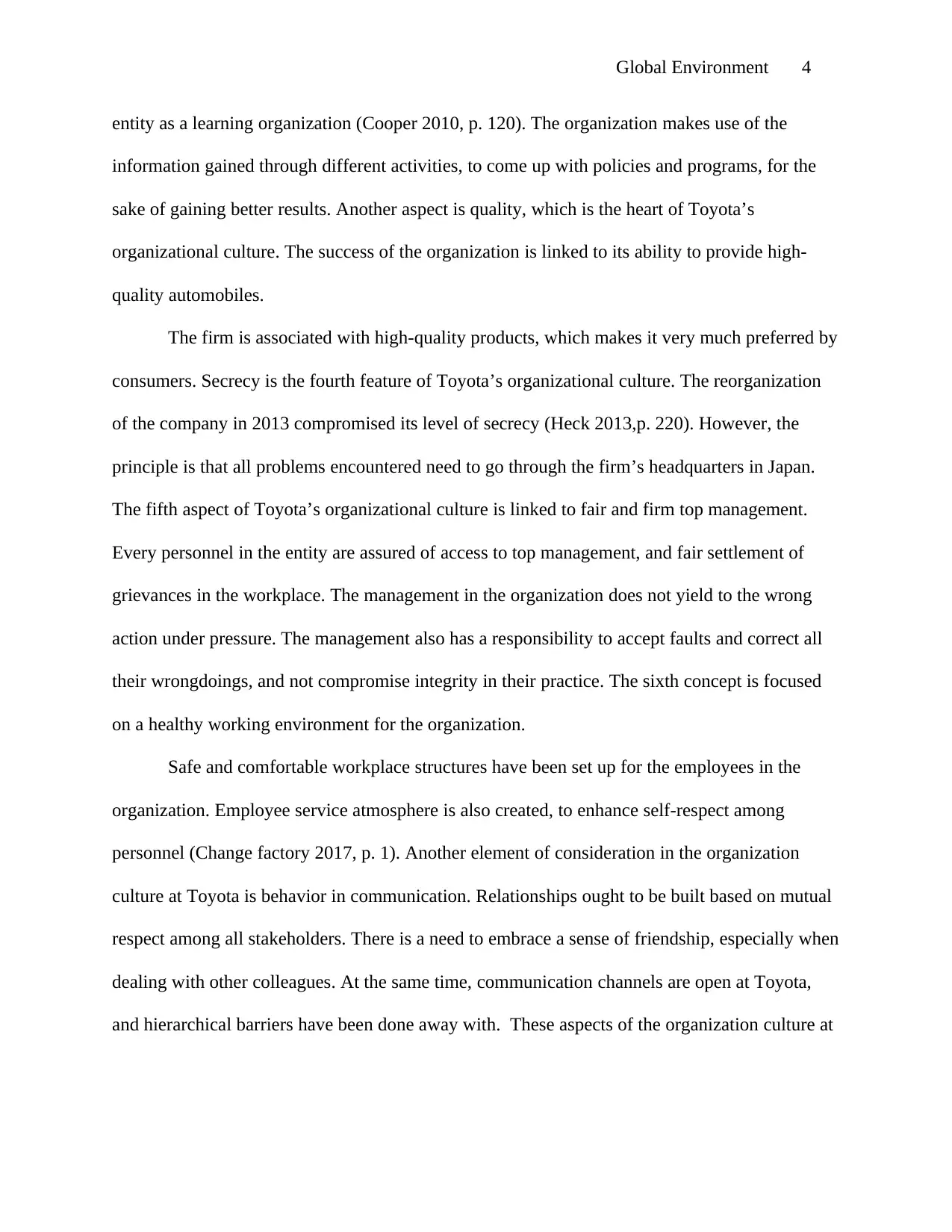
Global Environment 4
entity as a learning organization (Cooper 2010, p. 120). The organization makes use of the
information gained through different activities, to come up with policies and programs, for the
sake of gaining better results. Another aspect is quality, which is the heart of Toyota’s
organizational culture. The success of the organization is linked to its ability to provide high-
quality automobiles.
The firm is associated with high-quality products, which makes it very much preferred by
consumers. Secrecy is the fourth feature of Toyota’s organizational culture. The reorganization
of the company in 2013 compromised its level of secrecy (Heck 2013,p. 220). However, the
principle is that all problems encountered need to go through the firm’s headquarters in Japan.
The fifth aspect of Toyota’s organizational culture is linked to fair and firm top management.
Every personnel in the entity are assured of access to top management, and fair settlement of
grievances in the workplace. The management in the organization does not yield to the wrong
action under pressure. The management also has a responsibility to accept faults and correct all
their wrongdoings, and not compromise integrity in their practice. The sixth concept is focused
on a healthy working environment for the organization.
Safe and comfortable workplace structures have been set up for the employees in the
organization. Employee service atmosphere is also created, to enhance self-respect among
personnel (Change factory 2017, p. 1). Another element of consideration in the organization
culture at Toyota is behavior in communication. Relationships ought to be built based on mutual
respect among all stakeholders. There is a need to embrace a sense of friendship, especially when
dealing with other colleagues. At the same time, communication channels are open at Toyota,
and hierarchical barriers have been done away with. These aspects of the organization culture at
entity as a learning organization (Cooper 2010, p. 120). The organization makes use of the
information gained through different activities, to come up with policies and programs, for the
sake of gaining better results. Another aspect is quality, which is the heart of Toyota’s
organizational culture. The success of the organization is linked to its ability to provide high-
quality automobiles.
The firm is associated with high-quality products, which makes it very much preferred by
consumers. Secrecy is the fourth feature of Toyota’s organizational culture. The reorganization
of the company in 2013 compromised its level of secrecy (Heck 2013,p. 220). However, the
principle is that all problems encountered need to go through the firm’s headquarters in Japan.
The fifth aspect of Toyota’s organizational culture is linked to fair and firm top management.
Every personnel in the entity are assured of access to top management, and fair settlement of
grievances in the workplace. The management in the organization does not yield to the wrong
action under pressure. The management also has a responsibility to accept faults and correct all
their wrongdoings, and not compromise integrity in their practice. The sixth concept is focused
on a healthy working environment for the organization.
Safe and comfortable workplace structures have been set up for the employees in the
organization. Employee service atmosphere is also created, to enhance self-respect among
personnel (Change factory 2017, p. 1). Another element of consideration in the organization
culture at Toyota is behavior in communication. Relationships ought to be built based on mutual
respect among all stakeholders. There is a need to embrace a sense of friendship, especially when
dealing with other colleagues. At the same time, communication channels are open at Toyota,
and hierarchical barriers have been done away with. These aspects of the organization culture at
Paraphrase This Document
Need a fresh take? Get an instant paraphrase of this document with our AI Paraphraser
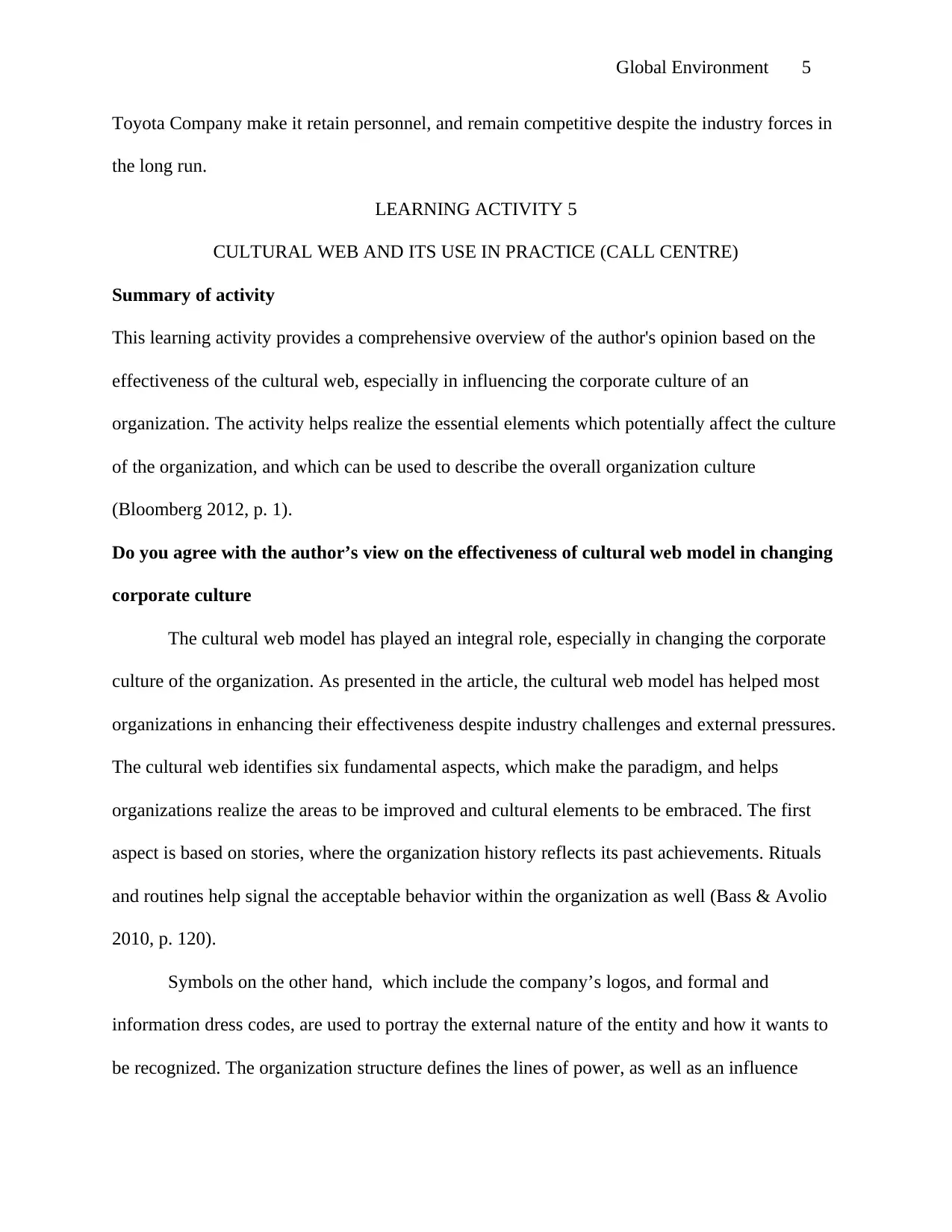
Global Environment 5
Toyota Company make it retain personnel, and remain competitive despite the industry forces in
the long run.
LEARNING ACTIVITY 5
CULTURAL WEB AND ITS USE IN PRACTICE (CALL CENTRE)
Summary of activity
This learning activity provides a comprehensive overview of the author's opinion based on the
effectiveness of the cultural web, especially in influencing the corporate culture of an
organization. The activity helps realize the essential elements which potentially affect the culture
of the organization, and which can be used to describe the overall organization culture
(Bloomberg 2012, p. 1).
Do you agree with the author’s view on the effectiveness of cultural web model in changing
corporate culture
The cultural web model has played an integral role, especially in changing the corporate
culture of the organization. As presented in the article, the cultural web model has helped most
organizations in enhancing their effectiveness despite industry challenges and external pressures.
The cultural web identifies six fundamental aspects, which make the paradigm, and helps
organizations realize the areas to be improved and cultural elements to be embraced. The first
aspect is based on stories, where the organization history reflects its past achievements. Rituals
and routines help signal the acceptable behavior within the organization as well (Bass & Avolio
2010, p. 120).
Symbols on the other hand, which include the company’s logos, and formal and
information dress codes, are used to portray the external nature of the entity and how it wants to
be recognized. The organization structure defines the lines of power, as well as an influence
Toyota Company make it retain personnel, and remain competitive despite the industry forces in
the long run.
LEARNING ACTIVITY 5
CULTURAL WEB AND ITS USE IN PRACTICE (CALL CENTRE)
Summary of activity
This learning activity provides a comprehensive overview of the author's opinion based on the
effectiveness of the cultural web, especially in influencing the corporate culture of an
organization. The activity helps realize the essential elements which potentially affect the culture
of the organization, and which can be used to describe the overall organization culture
(Bloomberg 2012, p. 1).
Do you agree with the author’s view on the effectiveness of cultural web model in changing
corporate culture
The cultural web model has played an integral role, especially in changing the corporate
culture of the organization. As presented in the article, the cultural web model has helped most
organizations in enhancing their effectiveness despite industry challenges and external pressures.
The cultural web identifies six fundamental aspects, which make the paradigm, and helps
organizations realize the areas to be improved and cultural elements to be embraced. The first
aspect is based on stories, where the organization history reflects its past achievements. Rituals
and routines help signal the acceptable behavior within the organization as well (Bass & Avolio
2010, p. 120).
Symbols on the other hand, which include the company’s logos, and formal and
information dress codes, are used to portray the external nature of the entity and how it wants to
be recognized. The organization structure defines the lines of power, as well as an influence
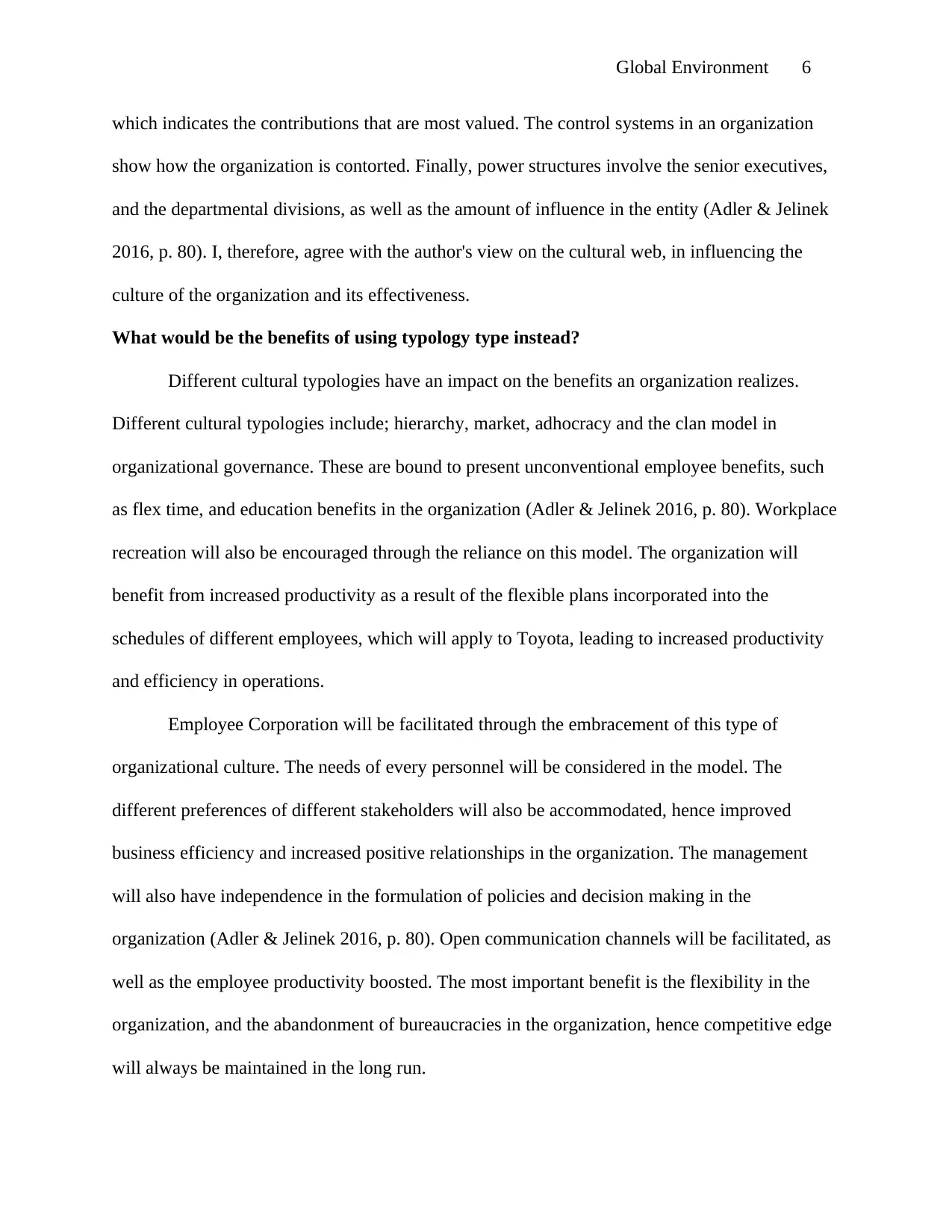
Global Environment 6
which indicates the contributions that are most valued. The control systems in an organization
show how the organization is contorted. Finally, power structures involve the senior executives,
and the departmental divisions, as well as the amount of influence in the entity (Adler & Jelinek
2016, p. 80). I, therefore, agree with the author's view on the cultural web, in influencing the
culture of the organization and its effectiveness.
What would be the benefits of using typology type instead?
Different cultural typologies have an impact on the benefits an organization realizes.
Different cultural typologies include; hierarchy, market, adhocracy and the clan model in
organizational governance. These are bound to present unconventional employee benefits, such
as flex time, and education benefits in the organization (Adler & Jelinek 2016, p. 80). Workplace
recreation will also be encouraged through the reliance on this model. The organization will
benefit from increased productivity as a result of the flexible plans incorporated into the
schedules of different employees, which will apply to Toyota, leading to increased productivity
and efficiency in operations.
Employee Corporation will be facilitated through the embracement of this type of
organizational culture. The needs of every personnel will be considered in the model. The
different preferences of different stakeholders will also be accommodated, hence improved
business efficiency and increased positive relationships in the organization. The management
will also have independence in the formulation of policies and decision making in the
organization (Adler & Jelinek 2016, p. 80). Open communication channels will be facilitated, as
well as the employee productivity boosted. The most important benefit is the flexibility in the
organization, and the abandonment of bureaucracies in the organization, hence competitive edge
will always be maintained in the long run.
which indicates the contributions that are most valued. The control systems in an organization
show how the organization is contorted. Finally, power structures involve the senior executives,
and the departmental divisions, as well as the amount of influence in the entity (Adler & Jelinek
2016, p. 80). I, therefore, agree with the author's view on the cultural web, in influencing the
culture of the organization and its effectiveness.
What would be the benefits of using typology type instead?
Different cultural typologies have an impact on the benefits an organization realizes.
Different cultural typologies include; hierarchy, market, adhocracy and the clan model in
organizational governance. These are bound to present unconventional employee benefits, such
as flex time, and education benefits in the organization (Adler & Jelinek 2016, p. 80). Workplace
recreation will also be encouraged through the reliance on this model. The organization will
benefit from increased productivity as a result of the flexible plans incorporated into the
schedules of different employees, which will apply to Toyota, leading to increased productivity
and efficiency in operations.
Employee Corporation will be facilitated through the embracement of this type of
organizational culture. The needs of every personnel will be considered in the model. The
different preferences of different stakeholders will also be accommodated, hence improved
business efficiency and increased positive relationships in the organization. The management
will also have independence in the formulation of policies and decision making in the
organization (Adler & Jelinek 2016, p. 80). Open communication channels will be facilitated, as
well as the employee productivity boosted. The most important benefit is the flexibility in the
organization, and the abandonment of bureaucracies in the organization, hence competitive edge
will always be maintained in the long run.
⊘ This is a preview!⊘
Do you want full access?
Subscribe today to unlock all pages.

Trusted by 1+ million students worldwide
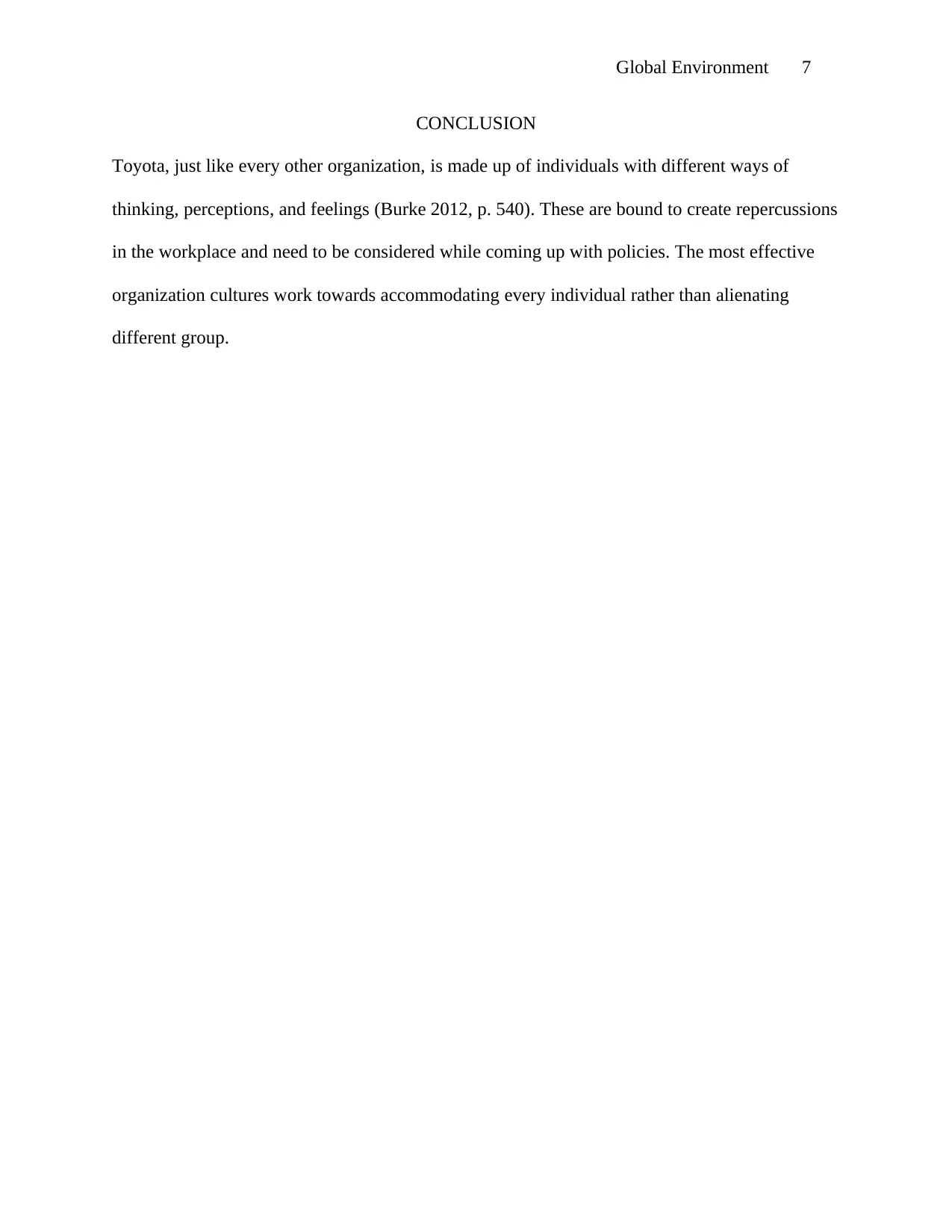
Global Environment 7
CONCLUSION
Toyota, just like every other organization, is made up of individuals with different ways of
thinking, perceptions, and feelings (Burke 2012, p. 540). These are bound to create repercussions
in the workplace and need to be considered while coming up with policies. The most effective
organization cultures work towards accommodating every individual rather than alienating
different group.
CONCLUSION
Toyota, just like every other organization, is made up of individuals with different ways of
thinking, perceptions, and feelings (Burke 2012, p. 540). These are bound to create repercussions
in the workplace and need to be considered while coming up with policies. The most effective
organization cultures work towards accommodating every individual rather than alienating
different group.
Paraphrase This Document
Need a fresh take? Get an instant paraphrase of this document with our AI Paraphraser
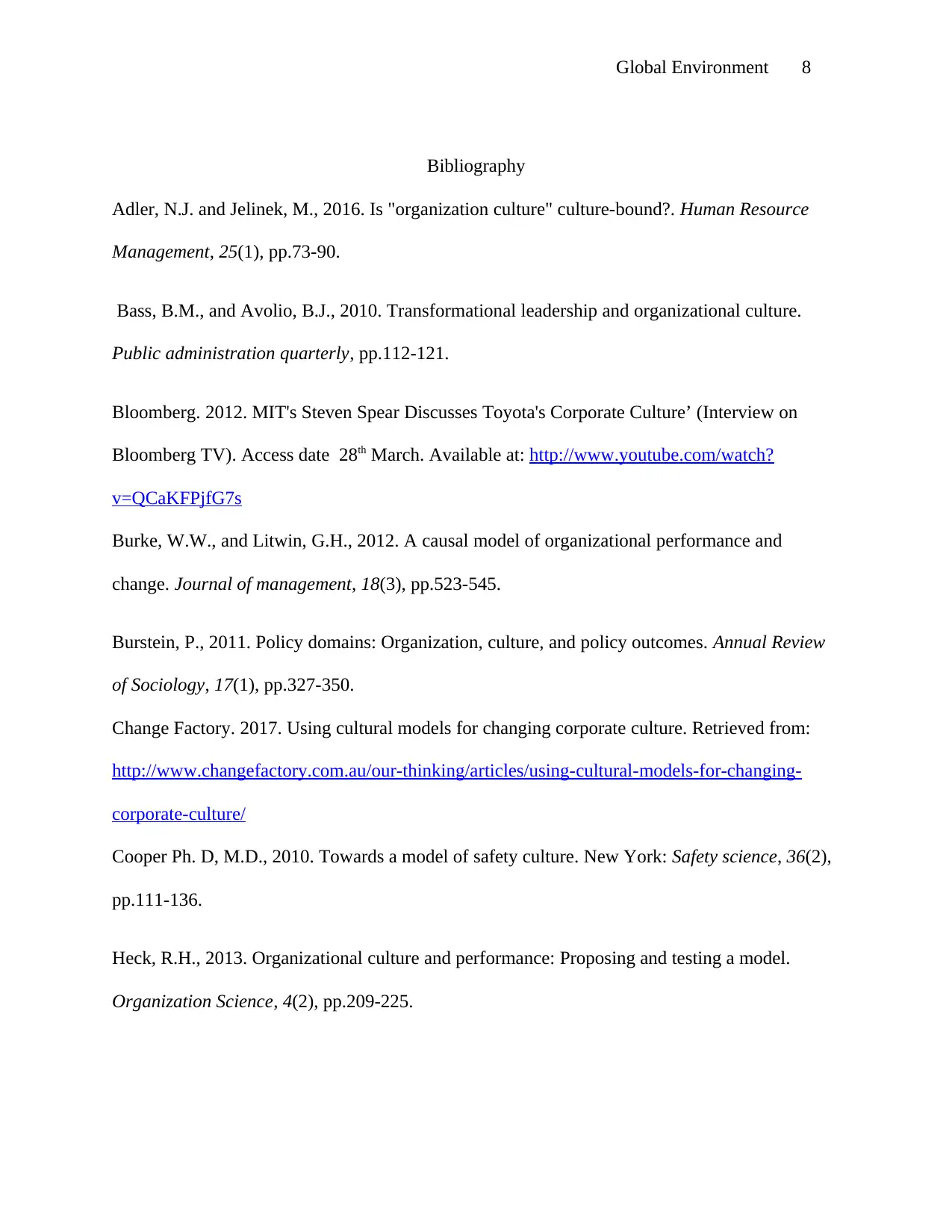
Global Environment 8
Bibliography
Adler, N.J. and Jelinek, M., 2016. Is "organization culture" culture-bound?. Human Resource
Management, 25(1), pp.73-90.
Bass, B.M., and Avolio, B.J., 2010. Transformational leadership and organizational culture.
Public administration quarterly, pp.112-121.
Bloomberg. 2012. MIT's Steven Spear Discusses Toyota's Corporate Culture’ (Interview on
Bloomberg TV). Access date 28th March. Available at: http://www.youtube.com/watch?
v=QCaKFPjfG7s
Burke, W.W., and Litwin, G.H., 2012. A causal model of organizational performance and
change. Journal of management, 18(3), pp.523-545.
Burstein, P., 2011. Policy domains: Organization, culture, and policy outcomes. Annual Review
of Sociology, 17(1), pp.327-350.
Change Factory. 2017. Using cultural models for changing corporate culture. Retrieved from:
http://www.changefactory.com.au/our-thinking/articles/using-cultural-models-for-changing-
corporate-culture/
Cooper Ph. D, M.D., 2010. Towards a model of safety culture. New York: Safety science, 36(2),
pp.111-136.
Heck, R.H., 2013. Organizational culture and performance: Proposing and testing a model.
Organization Science, 4(2), pp.209-225.
Bibliography
Adler, N.J. and Jelinek, M., 2016. Is "organization culture" culture-bound?. Human Resource
Management, 25(1), pp.73-90.
Bass, B.M., and Avolio, B.J., 2010. Transformational leadership and organizational culture.
Public administration quarterly, pp.112-121.
Bloomberg. 2012. MIT's Steven Spear Discusses Toyota's Corporate Culture’ (Interview on
Bloomberg TV). Access date 28th March. Available at: http://www.youtube.com/watch?
v=QCaKFPjfG7s
Burke, W.W., and Litwin, G.H., 2012. A causal model of organizational performance and
change. Journal of management, 18(3), pp.523-545.
Burstein, P., 2011. Policy domains: Organization, culture, and policy outcomes. Annual Review
of Sociology, 17(1), pp.327-350.
Change Factory. 2017. Using cultural models for changing corporate culture. Retrieved from:
http://www.changefactory.com.au/our-thinking/articles/using-cultural-models-for-changing-
corporate-culture/
Cooper Ph. D, M.D., 2010. Towards a model of safety culture. New York: Safety science, 36(2),
pp.111-136.
Heck, R.H., 2013. Organizational culture and performance: Proposing and testing a model.
Organization Science, 4(2), pp.209-225.
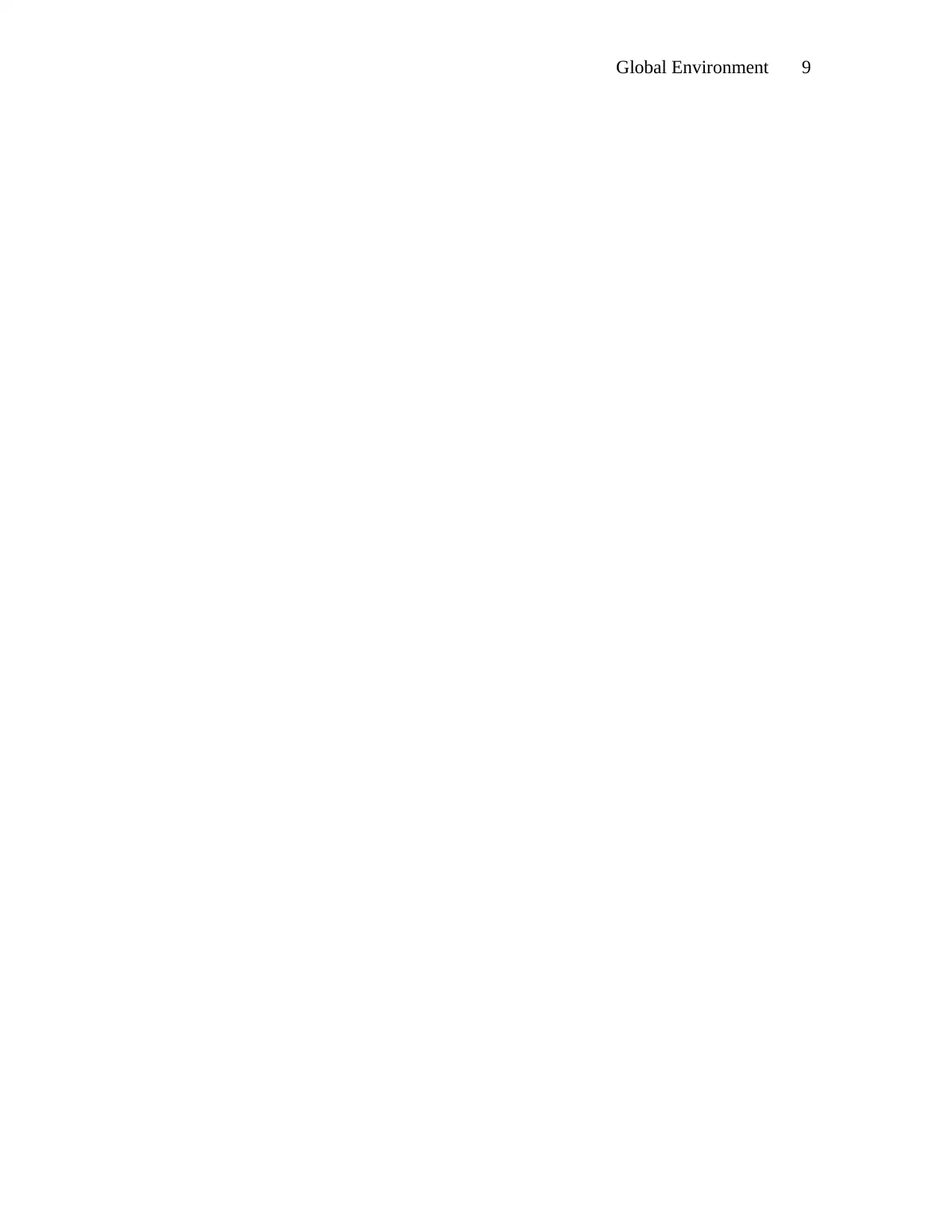
Global Environment 9
⊘ This is a preview!⊘
Do you want full access?
Subscribe today to unlock all pages.

Trusted by 1+ million students worldwide
1 out of 9
Related Documents
Your All-in-One AI-Powered Toolkit for Academic Success.
+13062052269
info@desklib.com
Available 24*7 on WhatsApp / Email
![[object Object]](/_next/static/media/star-bottom.7253800d.svg)
Unlock your academic potential
Copyright © 2020–2025 A2Z Services. All Rights Reserved. Developed and managed by ZUCOL.




